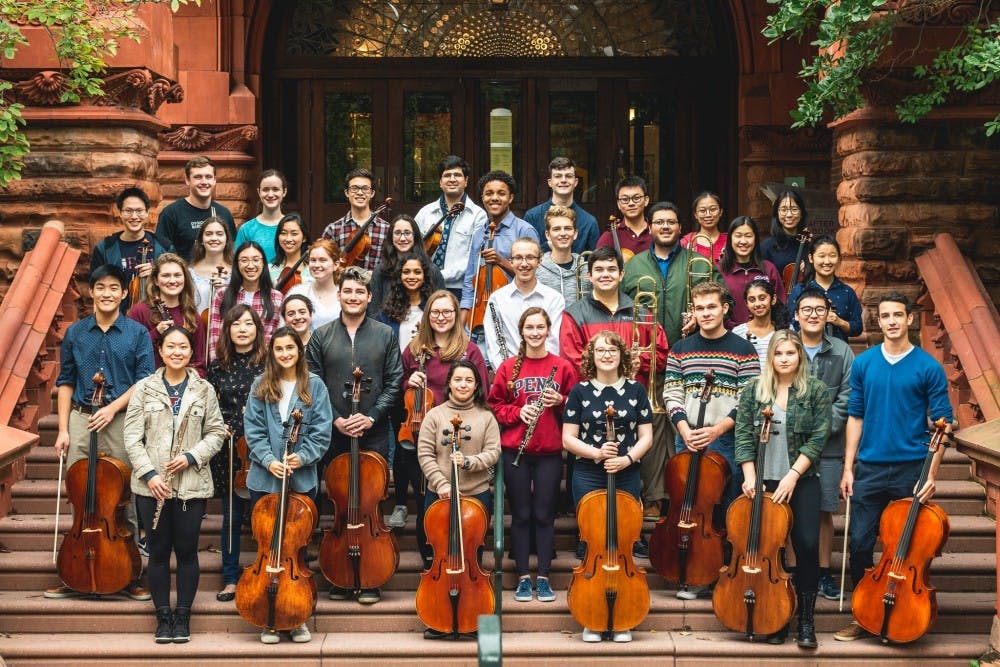On Friday evening, October 19, Irvine Auditorium rang with the rustle of seating audience members and the reverberation of hushed whispers, all in anticipation for the Penn Symphony Orchestra. The lights dimmed, the stage filled. Orchestra players filed in in black formal attire, the strings front and center, the woodwind and brass instruments further away, and percussions and the harp at the back. Penn students weren't the only performers here. From gradate students, to Penn faculty, to the occasional professor, even high school students from the local Philadelphia area, considering just the members onstage, the orchestral community was a diverse team around one hundred strong.
Similarly, the performers' diversity was reflected in its audience. Seated among the students were parents and family members who had arrived in time to kick off Family Weekend with music, alumni who came back to reminisce on their days in the orchestra, and campus faculty who'd come to unwind after a hectic week.
Once the orchestra settled down, in came the conductor. Even from rows of seats away, Thomas Hong, hailed by Kurt Masur as "one of the most talented young conductors of his generation," exuded enthusiasm. He leapt onto the podium and bowed to the audience with a smile. He turned back to the orchestra. A measured twist of his arm flicked his baton before him; Hong raised it up, swung it down and proceeded to spin a symphony the way one does magic with a wand. It began low and slow, a mere trickle of sound, before picking up in tempo as the woodwinds and brass joined in with the opening strings, like whitewater gushing past our ears. The audience was enraptured and washed away, each a stone buried beneath this flood of music, only breaking their silence to applaud after each piece.
The night's performance featured an array of pieces, most prominently Tchaikovsky's Symphony No. 4, which encompassed the entire latter half of the show. Vickie Yin (C '19), President of the Penn Orchestra, notes they "don't shy away from challenges." While tackling such a complex piece, conductor Hong's strong leadership is integral to "keeping the orchestra together, also important for motivating the orchestra," but even more important is the team's sense of cohesion. Despite possessing "players that are good enough to go on to music school," Vickie's favorite part of the orchestra is their emphasis on cooperation over competition. The team's focus on friendship persists regardless of the grind of rehearsals twice a week, four hours a week in total. When each piece ends, orchestra members tap their feet in place on the wood floors of the stage, each applauding themselves and cheering on each other, even as their hands are heavy with instruments and their eyes remain trained on the sheet music.
As a musician, Vickie continues, one of the best parts of playing onstage would be hearing the audience's cheers and whoops, or in some occasions seeing the more humorous displays of support, such as when peers "bring in posters or signs to show the faces of people in the orchestra." She said that the performers are especially "grateful for friends who would sit through an hour and a half concert on a Friday night, a busy weekend," to show their appreciation for the orchestra's labor of love.
Throughout the program, Conductor Thomas Hong directed his musicians the way a puppet master directs his puppets, smoothly and with precision. That is not to say the orchestra was without their own volition—each performer was committed to their role in the piece, not a stroke of the strings nor a note of the woodwinds were without emotion. The Penn Orchestra fitted together seamlessly, like the cogs of a well–oiled machine. So the conductor jerked his baton in small quick movements, so the music fell quiet but increased in pace; so he threw his arm out and above, so the symphony rose to an uproar. A fanfare of horns and bassoons and winds called to the audience in triumph. If joy was ever audible, it would have sounded like this. Excitement, happiness, and exuberance rose thick in the air, ending the performance with a bang.
The audience smattered in applause. Standing ovations were given, the admirers' silhouettes black against the gold light onstage as conductor Hong bowed with arms crossed over his chest and the orchestra beamed, breathless and exhausted but no doubt ready for future programs to come.

